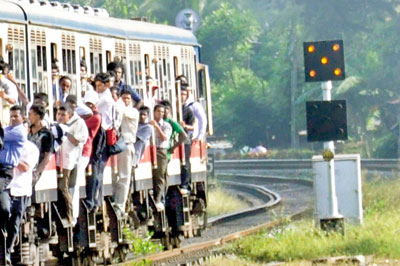Sunday Times 2
Expert backs local signals system for new railway lines
View(s):By Priyal de Silva
Reference to article titled “Offer by railways sidetracked: China gets huge signal contract” in the Sunday Times of April 30.
The colour light signalling system was originally installed between Veyangoda and Panadura in 1964 when B.D. Rampala was the General Manager Railways (GMR). The system was a world recognised and proven system procured from Ericssons of Sweden. The system was later extended from Ragama to Negombo on the Puttalam line. In later years railway officials extended the system on the main line from Veyangoda up to Polgahawela which as a station operated a mechanical colour light system for single directional travel on the double line with automatic blocks in between stations, so that more than one train could occupy sections between stations.

Local railway engineers have the expertise and experience to instal signals systems
In 1998, two projects of double tracking, viz. Panadura to Wadduwa, and Polgahawela to Rambukkana, were taken up by Sri Lanka Railways using its own skills within the department, when W.K.B. Weragama was the GMR. The extension of the colour light signalling system in these two sections was installed by the railway engineers, led by former Chief Signals and Telecom Engineer (CSTE) D.G. Hemachandra without any foreign assistance.
In 2003, with the completion of the double track between Ragama and Ja-Ela on the Puttalam line, and between Wadduwa and Kalutara North on the coast line, when I served as the GMR, the railway engineers installed colour light systems for these two sections without any outside assistance.
Later in 2007, when Dr. T.L. Gunaruwan was the GMR, with high intensity trains running between Peradeniya and Kandy, a colour light system covering this stretch was installed by a Railway team led by Chief Signals and Telecom Engineer Hemachandra and his deputy Palitha Samarasinghe without any outside assistance.
Cost effective
Recently the colour light system was extended from Maradana to Narahenpita, apparently using one of the most modern technologies, by railway officials led by the J.I.D. Jayasundera, CSTE, under the direction of the incumbent GMR B.A.P. Ariyaratne.
These achievements show that Sri Lanka’s railway officials possess the necessary skills and are confident that they have the ability to instal colour light systems for any new line, provided the necessary material and equipment are procured. It is learnt that the signalling system at Narahenpita cost only Rs.16 million and this implies that a system covering the four stations between Matara and Beliatta could be installed at a cost of less than Rs.100 million — a much lesser cost than the Rs. 250 million offer which (according to the media report) the Sri Lanka Railway quoted for this particular job.
Therefore, as a senior engineer, and past President of the Institution of Engineers Sri Lanka, and as Past Chairman of the Institute of Logistics and Transport Sri Lanka, it is my opinion that we could save much foreign exchange, if we could make such installations with local expertise. Even the maintenance can be attended to by railway officials with minimum foreign exchange for procurement of spare parts.
In case of any further extensions of lines in the network, the question of compatibility with the existing system will not arise if installation is done locally. Moreover our technicians and engineers will get an opportunity to further develop their competence, know-how and confidence in tackling such jobs, without depending on foreign countries and expertise.
This will also generate encouragement and enthusiasm among locals to produce the necessary spares and equipment for signalling systems and skill for national development by saving scarce capital resources, stimulating the economic multiplier effect. Such a strategy would eventually lead to minimising (a) the country’s foreign debt burden,(b) the necessity to sell/lease its own strategic assets to settle debts, and also to maximise (i) employment creation for our own labour and entrepreneurship and (iii) economic growth.
Therefore, it is high time that the decision makers in the Railway Department, and in the Ministry of Transport as well as in professional bodies such as the Institution of Engineers, the Chartered Institute of Logistics and Transport and the Sri Lankan Economics Association, advise the Government to implement such techno-economically sustainable public sector project development and execution strategies. It might be worthwhile to learn from our neighbour India which followed this path to become self-reliant in both expertise and equipment.
I wish this article will catch the eye of both the President and the Prime Minister who will in turn advise their political colleagues about the benefits of efficiently investing public capital resources, not only in the railway sector, but also in other development domains. It is their duty to implement public investment projects such that those that could use local labour, entrepreneurial and other physical inputs to the maximum extent, and be steered by local expertise, rather than investing in foreign procurements on a turnkey basis with foreign borrowings, which provides little or no benefit to the national economy or to the public at large.
(The writer was a General Manager at Sri Lanka Railways, Past President of the Institute of Engineers and past Chairman of the Institute of Logistics and Transport.)

